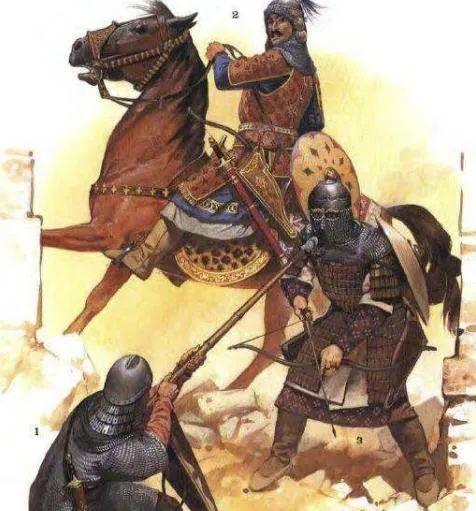
According to Egyptian data in 1181 AD, the number of Mamluk cavalry under Saladin's command was only 6976, of which 1553 were Ghulam warriors from the Khwarazm region, which shows that the main body of the Egyptian dynasty's 100,000 troops is still Middle Eastern, and the number of Hu soldiers and Hu generals is very rare. According to the Old Book of Tang, the Fan population had 20,000 households, accounting for one-third of the total population of Youzhou, and so on, the number of Hu people living in the north of the Tang Dynasty was as high as 6 million, and these large numbers of Hu people who migrated inland became the main source of rebels in the future Anshi Rebellion, and the number of Hu people in the Tang Dynasty was 1,000 times that of the Egyptian Dynasty.
"The chaos of Anshi, everything drove out of the Kou, and then disturbed the Central Plains."
Secondly, the Egyptian history books have never recorded that the Mamluk dynasty called itself Turkic, or worshiped the Hu culture, the whole of Egypt from top to bottom is very worshipful of the native Islamic culture, even the most hu blood of the monarch Bybels, Egyptian history books record that he was a Tatar, Bybels but the Arab Empire orthodox successor to the self-proclaimed, known as the servant of Islam, so arab civilization is still singing the praises of The great achievements of Bybels, it can be said that the Egyptian Dynasty employed six thousand Hu soldiers have long been Islamic indigenization.
"Servants of two holy cities".
On the contrary, the Tang Dynasty and the Later Tang Dynasty were very advocating Hu culture, And Li Chengqian, the eldest son of Tang Taizong Li Shimin, was obsessed with Turkic culture, Li Chengqian wore sheepskin jackets all day long in and out of the main hall, did not live in the Tang Palace, but set up tents outdoors to live in the wilderness, learning hu people to tie braided hairstyles, Li Chengqian was also fun with Hu people's dance and music all day long.
"Good Turkic words and obedience, the selection of the appearance of the beard, by the sheep fur, braided hair." "He also made dozens of household slaves learn the sound of sounds, learn the hu people's vertebrae, and cut the ribbon for the dance clothes." The sound of the drums and whips is endless day and night." "Five people build one fall, Zhang Heshe, build five wolves head silk, divide into halberds, tie banners, and set up a vault to pretend to themselves."
An Lushan, the tang dynasty's Three Towns Festival, was proud of the Zoroastrianism that worshiped Hu culture, claimed to be the god of light, and once declared himself to be possessed by the gods of the Hu people at a public meeting, hoping to win hu bing and Hu generals to follow him, so as to launch a rebellion with his life. After the Anshi Rebellion was settled, the Tang Dynasty sent envoys to the Heshuo area to destroy the Hu ancestral hall, which also caused a surge of dissatisfaction among the soldiers in the three towns, so the rebels in the three towns continued to divide and conquer, and their Hu culture was deeply rooted in the hearts of the people.
"In Kaiyuan and Tianbao, there are more Turkic gods in the human world than in the palace tune, which is also the response of Lushan." "To the assembly, Lu Shan stomped on a heavy bed, burned incense, Chen Weizhen, Hu hundreds of attendants, introduced To jia, Chen sacrificed, and the witch encouraged him to be a self-god."
The Later Tang Dynasty was founded by the Shatuo Turks, from the Chuyue Department of the Western Turk Khaganate, even if Li Keyong and Li Cunxun later moved to the Central Plains, the Later Tang Dynasty still worshipped Turkic gods very much, and the Tang Emperor once worshipped the Hu religion in Bai Sima Po, and in the "History of the Yunzhou Rebellion", it is clearly pointed out that the Tang Emperor worshipped the Turkic gods in order to stabilize the Hu generals who held military power.
"Shatuo Turks, other species of Bensic Turks". "June Gengzi, Fortunate White Sima Po, worship the Turkic gods." - History of the New Five Dynasties.
The eighth sultan of the Mamluk dynasty, Timid Buhua (captured Mongol creep, the same name as the Mongol general at the Battle of Ainjaru), who later became the monarch of Egypt, should the Mamluk dynasty be counted as a Mongol power? So the Hundred Years' War between Egypt and the Ilkhanate was a Mongol infighting? In fact, both the Turks and the Mongols were just migrant workers of Islamic civilization, and later the Arabs were dissatisfied with the rule of the Tatar monarchs, supported the Caucasian fighting peoples to come to power, easily overthrew the Tatar monarchs, and established the Burji dynasty.
According to the official population statistics of Egypt in 1995, there are 54.723 million people living in the Nile River Basin of Egypt, and Arabs account for 98% of the total population of the country. It can be seen that Egypt is a true European Caucasian, has nothing to do with the Turks, but has recruited six thousand Hu soldiers, do not overly assume that the Mamluk cavalry is Tatar.
conclusion:
The Number of Hu people in the Egyptian Dynasty was very rare, only 6,000 Tatar soldiers, and it had long been indigenized by Islam, and the degree of Huization of the Egyptian Dynasty was far less than that of the Tang Dynasty and the Later Tang Dynasty. Even the Tang Dynasty and the Later Tang Dynasty can be counted as the orthodox cultural continuation of the Central Plains Dynasty, and the Mamluk Dynasty is even less likely to be divided into the Hu Dynasty, and it is a very wrong view to unrealistically and excessively assume that the Mamluk cavalry is Tatar.